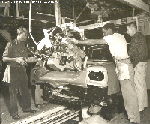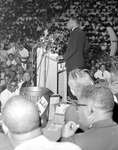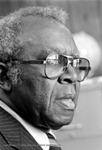
Driving While Black: The Car and Race Relations in Modern America
On the Line: Blacks and Auto Work
Blacks were not just consumers of the car. Their history was also intertwined with the history of automobile production. Here, too, the historical record was mixed. Detroit, the Motor City, became one of the most important destinations for black migrants from the south because of its reputation as a major center of car production. But the door to auto factory jobs opened slowly for blacks. Until World War II, the auto industry was not a particularly important employer of African Americans. The vast majority of blacks worked in service sector employment or in the agricultural sector. Before World War II, blacks found employment in only a handful of auto companies. Ford, Briggs, and Dodge pioneered the hiring of black workers. Still, in 1940, only three percent of the auto industry workforce was black, the vast majority of whom worked for Ford (where 12 percent of the workforce was black at the outset of World War II). Most black workers were overqualified for the jobs that they held. Economic historians Warren Whatley and Thomas Mahoney found that black automobile workers were better educated, older, and had more experience than their white counterparts. Because of pervasive discrimination against black workers, auto manufacturers were able to be picky--and select the most qualified black workers from the enormous pool. With few exceptions, blacks who were fortunate enough to get auto industry jobs found themselves confined to race-typed jobs such as maintenance work or employment in the hot and dangerous foundry or in the paint room, where they breathed noxious fumes.
World War II was a watershed in black employment. The war witnessed a burst of civil rights activism, led by black organizations and by interracial trade unions. In 1940, labor leader A. Philip Randolph threatened a March on Washington to demand the employment of blacks in wartime industry. In late June 1940, just weeks before the proposed march, President Franklin Roosevelt signed an executive order creating the federal Fair Employment Practices Committee (FEPC), a temporary agency that had as its mission the eradication of workplace discrimination. The FEPC was poorly funded--largely because of the opposition of Southern members of Congress to civil rights efforts. It held hearings and investigated workplace discrimination, although it achieved few victories. But whatever its weaknesses, the FEPC raised the consciousness of black workers and civil rights-oriented unionists who pushed for racial equality in the workplace. Throughout the country, black workers demanded equal opportunity in hiring and promotion, marched and engaged in wildcat strikes in the workplace to demand fair treatment, and used union-negotiated contracts to ensure that blacks and whites received equal pay and equal protection under seniority and other workplace procedures.
Civil rights activism alone did not, however, open workplaces to blacks. Corporate leaders, facing a desperate shortage of workers because of wartime mobilization and the draft, opened their doors to black workers for the first time. By 1945, blacks comprised fifteen percent of Detroit's automobile industry workforce--a huge increase over the pre-World War II employment figures. Because auto industry jobs were unionized and relatively well-paying, black autoworkers formed a black labor "aristocracy." Work in auto plants was a big step up for blacks who had been disproportionately stuck in janitorial positions, personal service jobs, and menial farm labor before World War II. Auto industry jobs were unionized--and as a result paid relatively high wages, offered generous benefits (including, by the 1950s, medical insurance and pensions), and offered job protection through seniority rules. The United Automobile Workers union also created a Fair Employment Practices Department, beginning in 1944, which provided black workers with a way to redress their grievances against workplace discrimination and to organize to promote workplace civil rights.
Despite the big gains in auto work during World War II, blacks were still more likely to hold unskilled jobs than whites. They were concentrated in the least desirable auto industry jobs (for example, the foundries and paint rooms became overwhelmingly black departments in many auto plants). And blacks--because they were at the end of the seniority line--were especially vulnerable to layoffs and unemployment when auto plants reorganized work or shut down.
Blacks did not lose their foothold in the auto industry, but their fortunes were greatly affected by two major changes in auto production beginning in the immediate post-World War II years. First, auto manufacturers began to decentralize production, building new plants in suburban and rural areas, increasingly in the South. Many of the suburban and rural areas in the North had minuscule black populations--and thus heavily white workforces. And until the passage of the federal Civil Rights Act of 1964, most southern plants practiced overt racial segregation, shutting out blacks altogether or creating separate, segregated seniority lines. At the same time, many auto manufacturers introduced new "automated" technologies, designed to reduce the number of unskilled workers on assembly lines. Because blacks were overrepresented in the ranks of entry-level and unskilled workers, they bore the brunt of the job loss associated with automation. The great irony of postwar auto industry history was that just as blacks found themselves on the first rung of the ladder of economic mobility in the auto industry, that rung was cut away by decentralization and automation.
The civil rights legislation and grassroots black activism of the 1960s opened more auto industry jobs to blacks--mainly in the older plants located in major cities. In Detroit, in response to pressure from civil rights activists, the Big Three automobile manufacturers--Chrysler, Ford, and General Motors--reached out and created jobs for the "hardcore unemployed," largely young black men with little work experience. The Trade Union Leadership Council (TULC), a black-led reform organization created in the late 1950s, pushed for the expansion of the number of blacks into well-paying skilled positions and as foremen. Over the course of the 1960s, auto manufacturers (fearful of protests and possible lawsuits) expanded the rolls of black electricians, toolmakers, and pipe fitters.
By 1970, about one in five Detroit auto workers was black, a sizeable increase from 1960, when they held only about sixteen percent of auto industry jobs. Despite these gains, the racial hierarchy of auto assembly plants remained deeply entrenched. Relatively few blacks worked in the well-paying skilled trades; even fewer worked as foremen and superintendents; and hardly any had white-collar positions. Amidst the growing call for black power in the late 1960s, many auto assembly plants became racial battlegrounds. Black workers at Chrysler and Dodge plants--followed by their counterparts in many other assembly facilities--formed "Revolutionary Union Movements" or RUMs. From pickets to wildcat strikes to deliberate slow-downs on the assembly lines, the RUMs were the most visible manifestation of growing discontent among black workers.
That said, life was good for blacks who were able to hold onto their assembly line jobs. Steadily employed black auto workers made enough money to buy their own homes, to put away money for retirement, to own their own cars, and even to send their children to college. In metropolitan areas with big auto plants--like Detroit and Cleveland and Oakland--black auto workers were among the most visible leaders of labor organizations, churches, and civil rights groups. And even those who did not serve as organizational leaders often made important contributions to the burgeoning civil rights movement. It is no surprise that Detroit, the city with the largest number of black auto workers, was also home to the nation's largest chapter of the National Association for the Advancement of Colored People (NAACP) and some of the nation's most politically influential black churches. Auto work provided black workers with resources that few other jobs did--and they invested their resources back into community organizations and churches.
By the turn of the twenty-first century, however, auto work became less important a source of employment for blacks. Many new automobile plants opened in predominantly white sections of the upper South. Still others fled the United States altogether, locating production in places like small-town Ontario, Canada, and the Maquiladora region of Mexico (along the U.S.-Mexico border). The American-born automobile industry workforce--black and white--shrunk to a new low by 2000.
Over the last one hundred years, the automobile industry has played a crucial role in African American history, for blacks were both producers and consumers of the car. The car brought mobility--geographic and economic--to blacks. It freed them from the shackles of Jim Crow public transportation, became a symbol of black economic aspirations, and served as one of black America's major employers. Yet automobile-related discrimination and inequalities were frustratingly persistent. Blacks can use service station restrooms and stay in most roadside motels without hassle. Racially-mixed groups of people in cars do not generate much suspicion, as they did in the days of Jim Crow. But blacks are still less likely to own cars, more likely to pay more for them, and disproportionately likely to get pulled over because of their race. The history of the automobile and black America--like the history of American race relations itself--is a story of hopes only partially met, of opportunities found and lost. Encapsulated in the history of the car is story of black America's ongoing, still unfinished, struggle for freedom and equality.
<<Previous Section - Next Section>>
Introduction
The Car and Jim Crow
"Drivin' Down the Freeway": Blacks and Car Culture
Image Versus Reality
On the Line: Blacks and Auto Work
For Further Reading
Complete Text Printable View
About the Project | Credits | Contact Us | Student & Teacher Resources | Site Map
©2004-2010 Automobile in American Life and Society



